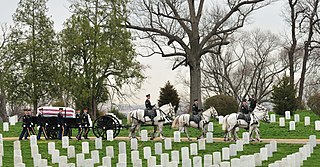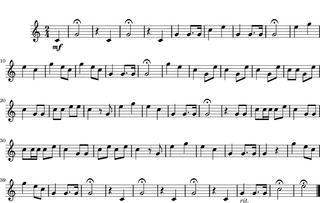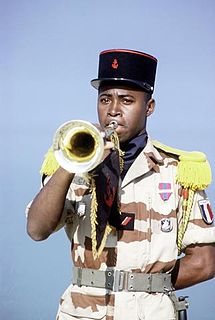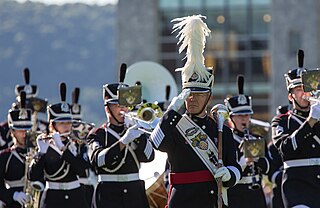
United States military music customs are the traditional, regulatory, and statutory provisions that guide performances by United States military bands during drill and ceremony and state occasions.

United States military music customs are the traditional, regulatory, and statutory provisions that guide performances by United States military bands during drill and ceremony and state occasions.

For hundreds of years, military forces have used music to signal their troops. [1] The use of music retains an important place in modern diplomatic protocol and military courtesy and is part of many official military events, such as state funerals, military parades, naval christening, officer-commissioning ceremonies, and promotion ceremonies.
Unlike other English-speaking nations, United States military band ceremonial music is not largely drawn from British military customs but is, rather, a mix of original styles and compositions and - to a lesser extent - French traditions. At the outset of the American Revolution, United States military units primarily relied on fife and drum corps for musical support. The U.S. was first introduced to the bugle horn (forerunner to the modern bugle) during the Battle of Harlem Heights, when British infantry used the instrument, causing Joseph Reed to later recall, "the enemy appeared in open view, and sounded their bugles in a most insulting manner, as is usual after a fox chase. I never felt such a sensation before—it seemed to crown our disgrace." [2] Some U.S. cavalry units adopted bugle horns during the war, however, a shortage of brass in the Thirteen Colonies largely limited use of the instrument to the opposing British and German forces, with U.S. troops continuing to rely heavily on fifes, drums, and even - at the Battle of Saratoga - turkey calls.
The modern bugle was first introduced to U.S. military units around the time of the War of 1812. [3] During that conflict, only the Rifle Regiment was authorized to use the bugle. All other U.S. forces were required to continue using the traditional U.S. fife. Gradually, however, bugles became more widely adopted by the United States military. U.S. bugle calls have largely been based on early French bugle calls (the notable exception is "Attention", which is taken from the British bugle call "Alarm"). [4]
The dawn of the "march music era" hastened the downfall of the fife and drum corps (today, the U.S. armed forces field just a single fife and drum corps among its nearly 150 bands). Aided by the large body of work being created by prolific U.S. composers such as John Philip Sousa, Henry Filmore and Edwin Eugene Bagley, U.S. military and military-like bands became known for performing a unique style of quick-tempo marches with thundering brass and heavy percussion. One music critic, writing about the Boston Jubilee of 1872, contrasted the "velvety smoothness" of the invited Band of the Grenadier Guards to the follow-up performance orchestrated by U.S. Army bandmaster general Patrick Gilmore which involved "a heterogeneous choir of nearly twenty thousand, an orchestra of about a thousand instrumentalists of decidedly mixed abilities, an organ blown by steam power ... a drum of the most preposterous magnitude, and a few batteries of artillery." [5]

Today, United States military bands employ music at various times as provided for in armed forces regulations, statute law, and customary practice.


The United States authorizes all military bands "band regalia" consisting of a unique unit drum major mace, baldric, tabard, and drum design. The United States Army Institute of Heraldry designs these items on behalf of military bands. [10]
In full parade dress, drum majors of many U.S. military bands wear bearskin hats. The origin of the use of bearskins in U.S. military bands dates to 1855 when United States Marine Band director Francis Scala adopted the style for that ensemble in emulation of European trends. This transition occurred as the band was reorganizing itself from a traditional U.S. fife and drum corps into its modern incarnation. A shortage of bearskins in the late 1880s caused the price of the hats to skyrocket, with The New York Times then reporting their use might be phased out entirely. "It can readily be seen what a price has to be paid for keeping up a custom which is rather old, it is true, but is practically a useless one save for the purpose of military display," the newspaper opined. [11]

"Taps" is a bugle call that is sounded as a signal for “lights out” at the end of a military day, and during patriotic memorial ceremonies and military funerals conducted by the United States Armed Forces. The official military version is played by a single bugle or trumpet, although other versions of the tune may be played in other contexts. It is also performed often at Girl Guide, Girl Scout, and Boy Scout meetings and camps. The tune is also sometimes known as "Butterfield's Lullaby", or by the first line of the lyric, "Day Is Done". The duration may vary to some extent.

A military band is a group of personnel that performs musical duties for military functions, usually for the armed forces. A typical military band consists mostly of wind and percussion instruments. The conductor of a band commonly bears the title of Bandmaster or Director of Music. Ottoman military bands are thought to be the oldest variety of military marching bands in the world, dating from the 13th century.

A military funeral is a memorial or burial rite given by a country's military for a soldier, sailor, marine or airman who died in battle, a veteran, or other prominent military figures or heads of state. A military funeral may feature guards of honor, the firing of volley shots as a salute, drumming and other military elements, with a flag draping over the coffin.

A Fife and drum corps is a musical ensemble consisting of fifes and drums. In the United States of America, fife and drum corps specializing in colonial period impressions using fifes, rope tension snare drums, and (sometimes) rope tension bass drums are known as Ancient Fife and Drum Corps. Many of these ensembles originated from a type of military field music.

"Reveille", called in French "Le Réveil" is a bugle call, trumpet call, drum, fife-and-drum or pipes call most often associated with the military; it is chiefly used to wake military personnel at sunrise. The name comes from réveille, the French word for "wake up".

The "Last Post" is either an A or a B♭ bugle call, primarily within British infantry and Australian infantry regiments, or a D or an E♭ cavalry trumpet call in British cavalry and Royal Regiment of Artillery, and is used at Commonwealth military funerals, and ceremonies commemorating those who have died in war.
Ruffles and flourishes are preceding fanfare for honors music, ceremonial music for distinguished people.

Beating Retreat is a military ceremony dating to 17th-century England and was first used to recall nearby patrolling units to their castle.

A bugle call is a short tune, originating as a military signal announcing scheduled and certain non-scheduled events on a military installation, battlefield, or ship. Historically, bugles, drums, and other loud musical instruments were used for clear communication in the noise and confusion of a battlefield. Naval bugle calls were also used to command the crew of many warships.

The United States Marine Band is the premier band of the United States Marine Corps. Established by act of Congress on July 11, 1798, it is the oldest of the United States military bands and the oldest professional musical organization in the United States. Today, the Marine Band includes the Marine Chamber Orchestra and Marine Chamber Ensembles.

United States military bands include musical ensembles maintained by the United States Army, United States Marine Corps, United States Navy, United States Air Force, and United States Coast Guard. More broadly, they can also include musical ensembles of other federal and state uniformed services, including the Public Health Service and NOAA Corps, the state defense forces, and the senior military colleges.

The Großer Zapfenstreich is a military ceremony performed in Germany and Austria. It is similar to the military tattoo ceremony performed in English-speaking countries, and is the most important ceremonial act executed by the German federal armed forces, the Bundeswehr, and by the Austrian federal armed forces Bundesheer. The Zapfenstreich is performed only during national celebrations and solemn public commemorations, to honour distinguished persons present at such special events. Examples are the farewell ceremony for a German federal president, or at the conclusion of large military exercises. It takes place in the evening hours and consists of a military formation of at least one military band, two platoons of armed infantrymen, and two lines of soldiers carrying torches, in total about 400 men.

The United States Army Old Guard Fife and Drum Corps is one of four premier musical organizations of the United States Army. Members perform using musical instruments and wearing uniforms similar to those used by military musicians of the Continental Army during the American Revolution.

Martial music or military music is a specific genre of music intended for use in military settings performed by professional soldiers called field musicians. Much of the military music has been composed to announce military events as with bugle calls and fanfares, or accompany marching formations with drum cadences, or mark special occasions as by military bands. However, music has been employed in battle for centuries, sometimes to intimidate the enemy and other times to encourage combatants, or to assist in organization and timing of actions in warfare. Depending on the culture, a variety of percussion and musical instruments have been used, such as drums, fifes, bugles, trumpets or other horns, bagpipes, triangles, cymbals, as well as larger military bands or full orchestras. Although some martial music has been composed in written form, other music has been developed or taught by ear, such as bugle calls or drum cadences, relying on group memory to coordinate the sounds.

A Corps of Drums, also sometimes known as a Fife and Drum Corps, Fifes and Drums or simply Drums is a unit of several national armies. Drummers were originally established in European armies to act as signallers. The major historical distinction between a military band and a corps of drums, was that 'drummers' were not employed to play their instruments to entertain or delight, but rather they carried out a utilitarian battlefield role. This role was fulfilled by trumpeters or buglers in the cavalry and the artillery, who did not form into comparative formed bodies in the way that drummers did; therefore, an orthodox corps of drums will exist in the infantry arm.

A drum major in the military is the individual leading a military band or a field unit. It is an appointment, not a military rank. Military drum majors utilize a ceremonial mace for giving commands while marching. Many drum majors, particularly American- or British-influenced ones, wear a sash that can carry embroidered badges of their home unit and battle honors; a pair of ceremonial drum sticks are often attached.

A military funeral in the United States is a memorial or burial rite conducted by the United States Armed Forces for a Soldier, Marine, Sailor, Airman, Guardian or Coast Guardsman who died in battle, a veteran, or other prominent military figures or a president. A military funeral may feature guards of honor, the firing of volley shots as a salute, drumming and other military elements, with a flag draping over the coffin.

The West Point Band is the U.S. Army's oldest active band and the oldest unit at the United States Military Academy, traces its roots to the American Revolutionary War. At that time, fifers and drummers were stationed with companies of minutemen on Constitution Island, across the river from West Point. In 1778, General Samuel Holden Parsons' 1st Connecticut Brigade crossed the Hudson River and established West Point as a permanent military post. After the American Revolution, Congress disbanded most of the Continental Army, but "the 55 men at West Point", members of the 2nd Continental Artillery, remained as they were. Among their ranks stood at least one drummer and one fifer, who alone maintained the tradition of military music at West Point.

The U.S. Army Herald Trumpets is a musical ensemble of the United States Army chiefly responsible for signaling the approach of the President of the United States at state occasions with entrance and exit fanfares. The unit is also charged with providing general public duties support in the Military District of Washington and beyond.

The military bands of the United Kingdom are musical units that serve for protocol and ceremonial duties as part of the British Armed Forces. They have been the basis and inspiration for many military bands in the former British Empire and the larger Commonwealth of Nations as well as musical organizations in other countries. Military musical units with British influence include United States military bands, the Japan Ground Self-Defense Force Music Corps and the Military Band of Athens. British military bands are controlled by the military music departments of the three services that compose the armed forces. These include the Royal Marines Band Service, the Royal Corps of Army Music, and the Royal Air Force Music Services. British style brass bands and carnival bands were then and are currently inspired by the British Armed Forces and its brass bands, especially of the Army's regular and reserve formations, as they follow a similar format as it relates to brass and percussion instruments.